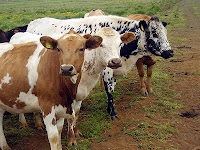Viking aficionados have known for a while that the British Museum was planning another big Viking exhibition. It's now been more than three decades since their last big one in 1980, which I remember well even though I was a mere cradolcild of a PhD student in London at the time. Now, more news is emerging about the new exhibition, which will be in 2013, and organised in cooperation with Copenhagen and Berlin.
The website of the National Museum of Denmark is promising the world's longest Viking ship (pictured above), affectionately known as Roskilde Wreck 6, one of several ships found in 1997 when the Viking Ship Museum in Roskilde was being expanded. The ship was made of oak, built probably in Norway around 1025, and was 36 m. long and 3.5 m. wide, with up to 78 oars and a crew therefore of around 100.
We are promised 'a new perspective on the world of the Vikings', with a concentration on four themes: (1) expansion and warfare; (2) power and aristocracy; (3) rituals and belief; and (4) cultural contacts and exchange. I'm already clearing my diary for 2013.
29 June 2010
19 June 2010
The Gods Live On
Two new craters resulting from the recent volcanic eruptions in Iceland have now been named, according to a report in Morgunblaðið. They're going to be called Magni and Móði after the two sons of Þórr who survived Ragnarök. Moreover, the new lava field is going to be called after the gods in general, Goðahraun. While I'm not aware of Móði having been used before (do correct me if I'm wrong), Magni is not new in modern nomenclature: the Icelandic for Mighty Mouse is Magni Mús! The original Magni plays a small part in the story of his father's duel with the giant Hrungnir. Þórr kills Hrungnir, who however falls on top of him, with his leg across Þórr's neck. The gods are unable to move Hrungnir's leg to rescue Þórr until the three year-old Magni comes along and does it. Snorri tells us that Þórr 'welcomed his son warmly and said he would grow up to be a powerful person'. Not unlike Mighty Mouse.
Volcanic Cows
I've heard a couple of versions of this story, this is the more plausible one. At around the time of the recent volcanic eruptions, a cow in Iceland gave birth to triplets, a rare enough occurrence in itself. As the calves happened to be two female and one male, they were immediately named Eyja, Fjalla and Jökull. Eyja and Fjalla, at least, will produce more milk for having names, as a study at the University of Newcastle, reported in The Times, has shown that cows with names give more milk. So no more Cow 214. If you are interested in Icelandic cows, there is a webpage devoted to them.
And if you are travelling in Iceland, I recommend a stop at the Cowshed Café, near Mývatn, where you can look at the cows through a window while you drink your coffee, as you can see from my photo, taken last summer.
03 June 2010
Are You Inspired by Iceland?
Doubtless, dear reader, if you have the slightest interest in these things, you willl already have become aware of the new campaign to promote Iceland, now at http://www.inspiredbyiceland.com/. It is described as 'the biggest campaign ever made to promote Iceland abroad' and is a cooperation of the government and the tourist industry, to counter the effects of the Eyjafjallajökull eruption, since many people abroad now apparently labour under the misconceptions that 'the whole land is covered with ash and that Iceland is in a state of emergency'. The website uses stories from people who have visited Iceland (including one who only spent four hours at the airport, but fell in love with the language!). But the best thing on it is the video, in which you see lots of people dancing in lots of scenic Icelandic places, including two Vikings, and some very wacky folkloric ladies. Well worth a look.
Subscribe to:
Posts (Atom)



